
(Images: PBOT)
As we reported last week, the Portland Bureau of Transportation is eager to make the Northeast Multnomah Street bikeway permanent.
In 2012 PBOT gave Multnomah a significant update in hopes that it would help aid redevelopment of the Lloyd District. They took an auto-only thoroughfare, added on-street auto parking (to help win over business owners) and built a protected bikeway (to honor an advisory committee’s support for making an adjacent street a major bikeway).
As the project got underway in late 2011, Portlanders were promised that the new street design would be “transformative” and “world-class”. In March 2012 former PBOT Director Tom Miller told us, “Who knows, in a couple years from now, this could be one of coolest streets in Portland.”
Over five years later the street still isn’t as safe and pleasant for cycling as it should be.
Thankfully it looks like PBOT has funding to make permanent changes that will help us come closer to achieving Multnomah’s potential (even though the street will still have four lanes for auto use). If you missed the recent open house, Go Lloyd (a city-funded transportation management association) put together an online version where you can view options and leave comments.
At this stage of the project PBOT has narrowed the design down to two concepts for the overall street cross-section and three options to deal with turning movements at intersections.
Keep in mind overall configuration of Multnomah — one standard lane, one bike lane and one parking lane in each direction — won’t change. The major difference will be a much wider bike lane.
Check out the options below and leave your comments at the Go Lloyd open house page…
Street Section Option 1: Sidewalk Level Cycle Track
Advertisement
Street Section Option 2: Cycle Track with Raised Buffer
Instersection Option 1: Bicycle Signals
Intersection Option 2: Combined Lane
Floating Transit Stop
You can leave comments on each option — and leave open-ended comments at GoLloyd.org.
— Jonathan Maus: (503) 706-8804, @jonathan_maus on Twitter and jonathan@bikeportland.org
BikePortland is supported by the community (that means you!). Please become a subscriber or an advertiser today.




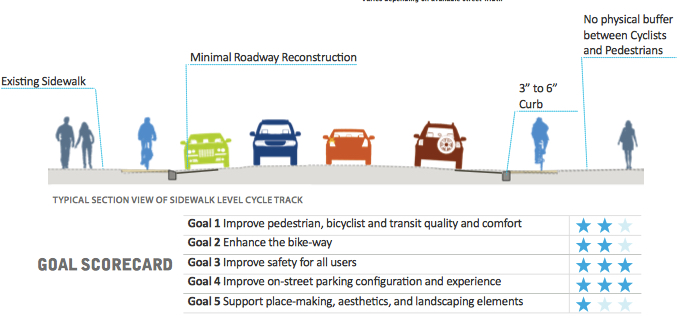
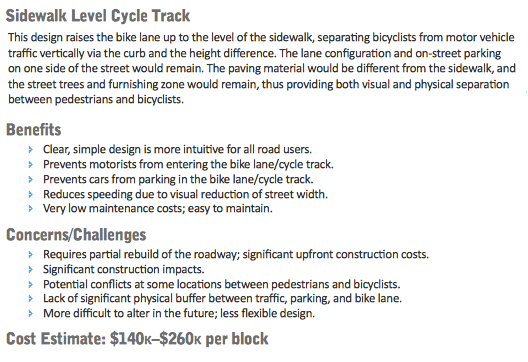








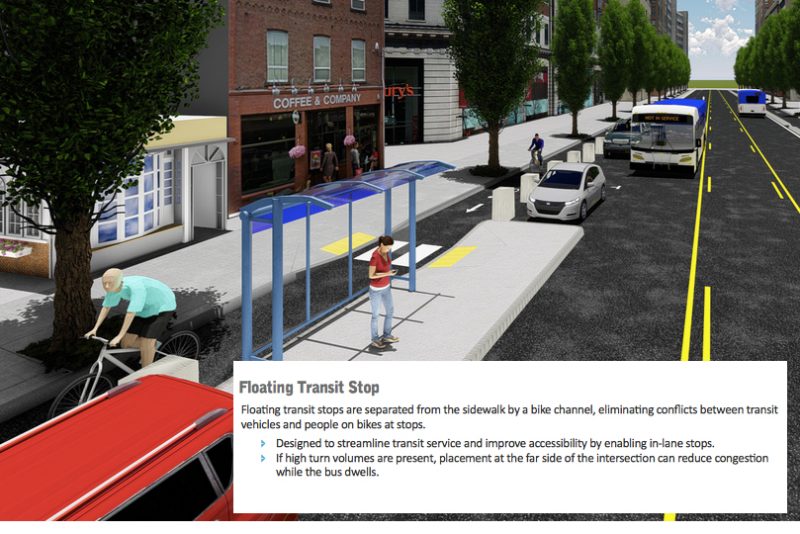


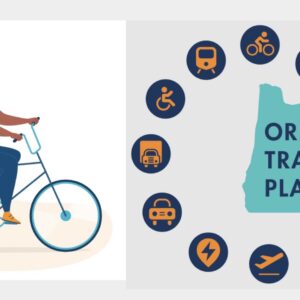
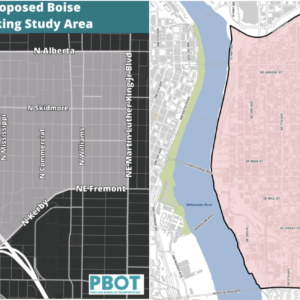
Thanks for reading.
BikePortland has served this community with independent community journalism since 2005. We rely on subscriptions from readers like you to survive. Your financial support is vital in keeping this valuable resource alive and well.
Please subscribe today to strengthen and expand our work.
On street section 2, why are there not bollards on both sides? The curb side seems too easy for delivery vehicles to jump and park in the bike lane, like I saw in Paris.
The other side is non-parking side. I think the designers are counting on car respecting the “No parking” sign more than the bike lane.
There can be, and quite a number of us have asked for them. That seemed to surprise both Go Lloyd and the city, but that is exactly what I want. Drivers see them. Drivers, where these have been installed, keep their distance. They are permeable, so you can get in and out of the protected lane when you need to.
… And where are all the curb cuts? The diagrams seem to be from some idealized Sim City that doesn’t look like any of the realities in the USA, with curb cuts, ADA ramps, mid-block crossings, homeless shopping carts, lines in front of food trucks, etc.
I don’t think these are intended to be construction drawings.
Gonna be honest, I’d take the less expensive option if it meant the rest of the money could be used towards more active transportation improvements. The I’d prefer sidewalk level, I’d take more improvements over less but more ideal.
The sidewalk level one seems like an interesting change and a good chance to see how well it works
These options all seem way too expensive for the modest improvement in safety and pleasantness relative to the existing configuration. I guess a promise made is a promise to be kept.
I’d pick the least expensive option and put any remainder into filling a critical gap in the system where the choice is between completely unsafe and better. I’m thinking projects like Barbur Boulevard, Taylors Ferry, crossings of Powell Boulevard, etc.
Really? I think the bollards are a major improvement for safety and to keep cars from parking/unloading in the bikeway. Bollards also provide some opportunity for landscaping or artwork.
On street for sure, to prevent cyclists drifting into pedestrian space and to keep us out where we can better see cars entering and exiting parking.
On street 100%.
Reinforces the idea that bikes are vehicles and consistent with legal framework.
Sill not sure why this area is getting so much attention. Hardly anyone uses the existing bike lanes. When will the city learn that bike infrastructure is a not supply-driven. There are many more important areas which could use the TLC being spent here.
Are you kidding? This is one of the more well-used bikeways we have in the Central City. It’s super-convenient since it’s the only real east-west connection in the middle of the Lloyd.
LOL, lights are totally not timed for cyclists, right-hook opportunities still abound …
I’m just saying plenty of people use it…
There’s massive development in that area, including a big apartment complex across from the mall and a huge new hotel next to the Convention Center. It’s also a hub for MAX & Street Car, so it makes sense for that area to be bike and pedestrian friendly.
Oh wait, I know why they are doing it here, because it is convenient and there is plenty of spare space!
Hassalo on Eighth.
Street.
In roadway would be preferred here, something like this example from the Netherlands Concrete buffer gives drivers a curb guide for parking, and having the cycleway lower than the sidewalk provides clear delineation for people walking (especially for those with vision impairments).
In the Netherlands the bikes are slightly below the sidewalk and slightly above the street. There are a million examples on Bicycle Dutch. Here’s one:

and in denmark.
bollards and cheap curbs are temporary structures that cost more to maintain (they are inevitable run over and bashed into) and can block sight lines. it’s sad to see portland once again propose sub-par infrastructure that was long ago rejected by nations with the bike mode share we aspire to.
Curbs and bollards “block sight lines”? Only if you are 4 inches tall.
go lloyd’s survey (which you may not have read) described something like this:
https://goo.gl/maps/1MqPTpcyYGC2
PS: A 4 inch bollard?
Those planter-protected bike lanes in Vancouver are great. Difference is there they actually have a curb and form a continuous line, where in Portland, PBOT just haphazardly plopped a few of them along SW 2nd without pouring any concrete. The Vancouver is solid without gaps and therefore looks far more welcoming.
I think it is likely that PBOT/go lloyd will install 2-3 foot box planters with 2+ feet of vegetation near intersections. After all, this kind of “beautiful” vegetative treatment increases land values and, most importantly, property taxes!
Most Dutch cycle-tracks where built at the same time as the roads themselves were built or rebuilt. It’s much harder with an existing street. We would have to rebuild the curb and move all the storm drains and that’s why it’s really expensive.
Agreed that it would be really expensive for the marginal difference it would make. I prefer a clearer delineation between bikeway and sidewalk anyway.
Based on how pedestrians wander between lanes on Better Naito, I’d agree.
Yes. As someone who has ridden thousands of miles on L.A.’s beachfront bike path/ped walks, it is inevitable that both groups ignore the lines. It is just human nature; oh, my lane is crowded, and there is nobody in this lane. It is not a big deal, as long as cyclists are going less than 10 mph, but faster travel becomes problematic.
Several thousand apartments will be built in the Lloyd District in the next few years, the mall will either become more active or it will be redeveloped too – there will be a lot more bike traffic on that street. The local business district seems supportive of a separated bike lane, which isn’t that common. And the money is available. So why not make this a demonstration, have it be a success, and a model for future separated bike lanes.
FWIW, you ignored the original question – sidewalk or street-level?
I chose street level.
Between the 2012 and whenever the final iteration gets built as much as 2,500 linear feet of sidewalk along NE Multnomah will have been rebuilt in connection with adjacent private development. Its a shame that upgrades to sections of the protected bike lane weren’t / won’t also be made as part of the Public Works Permitting process. In alternative scenario there could already a raised bike lane adjacent to Hassalo on Eighth, and others would be built in the next couple years adjacent to the Convention Center Hotel and Lloyd Cinemas redevelopment.
To do that requires an adopted Right-of-way Standards document like we have for South Waterfront or River District, which is a lot of time and effort. Not saying it shouldn’t have been done, but there’s a lot of resistance to doing them.
I certainly don’t want to be forced to use a sidewalk bike path with no exit strategy. If the bike lane is raised it needs a continuous mountable curb for its entire length. If the city wants to do something else that is not at street level they need to be advocating in Salem for repeal of ORS 814.420; I for one am tired of their endless experimental BS that ignores international best practice and you end up being forced to use by law. FTS!
Agreed. Stop forcing us to use sub-par experimental infrastructure.
And those plans have been very successful. As an example NW Pettygrove will soon have 7 out of 8 block faces built out to the special green street standards, without any public money spent. When the trees reach their mature size they’re going to make it one of the nicest streets in the central city.
So while I’m sure the planning for right-of-way standards takes some effort, the payoff is worth it.
Please no more bike lanes shared as sidewalks with only paint delineating. A big percentage of peds seem to have no conception of sharing, knowledge of or caring what painted bike and peds lanes even mean when on such routes. Walking 3 or 5 abreast across all lanes, walking contraflow (sometimes defiantly) walking with leashes strung across route, SUV size prams going down the middle and of course the countless iZombies with eyes down on screens and ears blocked with buds and apparently no even minimal awareness of their surroundings. Good place to experience this is crossing the Hawthorne Bridge (especially westbound) much of the Esplanade, Tilikum Crossing etc.
I know there’s lots of resentment and comment about inconsiderate cyclists on multi use routes but I rarely hear about the abominable behavior of many peds. I really try to be considerate when sharing such routes on a bike and wish the favor was even minimally returned. I suppose this will sound like a rant and isn’t PC, but really let’s be honest here. Seems a cultural issue as I’ve been on multi use routes in Europe and peds there seem to grasp the basics of awareness and knowledge… of at least the laws of physics 😉 In many cases I rate my chances interacting motorists as safer than with peds in the U.S. As Hair Furor would tweet – “sad!”
As one of the people who constantly whines about cyclist treatment of peds, I agree that ped behavior in cycle lanes leaves much to be desired. My daily commute takes me by PSU and other places where peds frequently treat the bike lanes like sidewalks or simply step into them.
A huge percentage of peds here don’t make eye contact or work with others to time approaches to minimize conflicts. Some even appear to try to time approaches to crossings to inconvenience others.
On many streets, I also feel safer with the cars. And frankly I enjoy riding with them more than inattentive cyclists or peds meandering about like stray chickens.
I guess this explains the negative attitude towards protected-cycling infrastructure and bicycular cycling…
Not at all VRU; it simply voices the view that cycling and ped lanes on mixed use routes need to be delineated/separated with more than paint. This is elementary and shouldn’t even have to be up for discussion. Again looking to cycling/ped infrastructures more advanced than ours we see it as basic and assumed planning and about as obvious as something can get. Yet we still debate as if trying to decide if square wheels roll as well as round ones! Isn’t this obvious?
This the full sentence and it says no such thing.
Give me stray chickens over texting drivers any day.
I’d prefer at-sidewalk-grade just to try something different.
Meh.
Why does street section option 1 have “More difficult to alter in the future; less flexible design.” under the Concerns/Challenges? I see this as a benefit because a less permanent option could be removed like Better Naito keeps being removed.
Oh come now…everyone knows that jack hammering away concrete bollards/curbs is far less challenging than simply extending the cycle track (as has been done often in nations with the mode share PDX aspires to).
Cycletrack extended temporarily: http://farm5.staticflickr.com/4114/4735172797_71101bfdaf.jpg
Cycletrack extended permanently:
https://goo.gl/maps/iKQPsLdb4E22
Cycletrack extended permanently:
https://goo.gl/maps/iKQPsLdb4E22
I’m sure this is amazing and all that, but when I look at this picture I think:
* How do I turn left?
* How do I take the lane to avoid a right hook and then return to the track?
* How do I leave & return to the track to avoid all of the crap that ends up on it? (Many of the bike lanes I use are regularly full of detritus from one side to the other)
* How do I pass a pack of slow moving cyclists at speed while giving extra clearance?
* What keeps pedestrians from walking onto this track without looking? A full-size curb at least gets some people to look before they step.
Oh man, Dan A, do I have some bad news for you. Cities all around the country are looking a the separated bike lanes in Denmark and the Netherlands to show them how to create bike lanes appropriate for casual riders. When they have the money, examples like the one you link to are what they’d like to build. You are in luck however, as most cities don’t have enough money to do the real thing, so they do it on the cheap with paint and plastic posts.
* How do I turn left?
You do a left turn in two stages. Also known as a Copenhagen left.
* How do I take the lane to avoid a right hook and then return to the track?
You don’t. Other geometric features create high yielding rates. In high volume situations, bike signals prevent right hooks.
* How do I leave & return to the track to avoid all of the crap that ends up on it? (Many of the bike lanes I use are regularly full of detritus from one side to the other)
The raised profile and low curbs on these cycle tracks collect much less debris than your street-level curb tight bike lanes. Copenhagen has a rigorous maintenance routine we should learn from.
That said, if you want to leave the track I bet you are skilled enough to hop the curb, or maybe you can exit at driveways.
* How do I pass a pack of slow moving cyclists at speed while giving extra clearance?
Look again at the link you posted. Those tracks are ~10 ft wide. This is plenty of room for you to ring a bell and pass a little kid and their parent with no trouble.
* What keeps pedestrians from walking onto this track without looking? A full-size curb at least gets some people to look before they step.
Pedestrians are delicate, and sensitive to grade changes. This curb is about 2″, which is fully detectable by blind pedestrians, and fully noticeable by other pedestrians.
I was told they would be held in place by unreasonably strong magnets. Electro magnets, so that if/when they needed to be moved (why?) the power could just be shut off?
On the street.
Regarding a height difference, how about splitting the difference? Have the cycle lane higher than the road but lower than the sidewalk.
The main things that are important are that motor vehicles are incapable of going into the cycle lane, so some type of strong barrier, and pedestrians sense by feel that they are walking out of the walking area. Paint won’t do that.
Asking PBOT (aka go lloyd) to build infrastructure that follows basic dutch and danish design standards is ridiculous. PBOT does the right thing, only after they have tried everything else.
What else do we pay for their trips to Denmark for, if not to come home and copy their designs?
Of those options, I guess I’d probably vote for barriers vs. raised to sidewalk level. Especially with the admission that the current planters get struck by motor vehicles on the regular, that says to me that they’re probably needed. (Definitely like those Dutch examples, though.)
More so than the specific lane treatment, though — I definitely want to see floating transit stops, and better intersections. All of the intersection treatments they’ve demoed still feel like compromises. The best treatment I can think of is one where there isn’t any right-turn conflict zone at all — that is, just disallow right turns for motor vehicles. Obviously not possible at every intersection along this corridor, but it should be seriously explored for some, e.g. at NE 6th or NE 3rd when traveling westbound.
And even with all of that … if you’d asked me what I wanted before they showed off their ideas, I would have just asked for an adjustment to the signal timing. They really don’t feel well-timed for biking or driving.
I do not want to ride on a sidewalk.
I do not want to ride between parked cars and a curb.
I do not want to increase the travel time of cars or bikes with the additional signal cycles.
None of the above, but if these are the only options, street level.
Yes, I agree with your statements. Here’s one more:
I do not want to share a dedicated bike lane with Uber/Lyft drivers, UPS vans, and Beer delivery trucks.
street level, with bollards on BOTH SIDES to prevent drivers from crashing into it…
we can use slim planters instead of bollards for aesthetics…
no curb as that prevents bikes from exiting the lane when they want…
I like the idea of having it between street and sidewalk level as if it’s its own mode of transportation…
Yes, this. I like the Dutch paths where they’re about an inch lower than the sidewalk, usually with 45º transitions so you can ride right on the edge and not catch your tire or pedal. The slight elevation difference and color/material difference is enough delineate the spaces and keep pets from wandering back and forth. Works quite well having spent many months riding on those paths in A’dam.
Why is everyone here so obsessed with being able to leave the cycleway? If it is designed well enough, you won’t have to leave.
Road, path, and passing situations frequently make this desirable.
Deciding what people don’t need to be able to do in advance often fails to address use cases designers didn’t anticipate. Also, trying to force behavior often causes problems greater than the ones the solutions are intended to solve.
For example, there are now bollards at Interstate and Tillamook to prevent cars from entering the bike lanes and there is only a short section where cars may cross the bike path along interstate to go up on the bridge. As someone who rides this every work day, my observation is that the “improvement” makes cars much more aggressive about speeding and cutting in front of cyclists rather than getting stuck waiting for a slow line of riders. Likewise, the cars move much more erratically to get through gaps between cyclists rather than smoothly merging the way they used to when there was much more space to work with. Passing for cyclists is also more difficult whether you’re going straight or up the bridge. The paint is a nice touch that helps remind drivers cyclists are there, but the bollards are bad for everyone.
I never ride on Interstate, so I’m not familiar with that intersection, but to me, that just sounds like bad design overall. A counter example (also terrible design) is the Orange Line MUP where PBOT attempted to accommodate all kinds of riders and give people options but ended up making the entire area so confusing that it’s essentially a free-for-all. It’s not clear at all where you are supposed to ride, so cyclists are all over the place.
The Dutch and Danish figured this out decades ago, so why are we still trying to figure this out in Portland? Just make the cycleway completely separated from motor traffic and wide enough to faster riders can pass slower ones. Giving people multiple options sounds nice on paper, but ends up just making things confusing for both new and seasoned riders.
It is bad design, and I don’t enjoy riding the Orange Line MUP for the exact reasons you mention.
Or an evasive maneuver might be necessary. For example, if some knuсklеhеad riding the wrong way while distracted by their cell phone suddenly veers at you. Who actually thinks every cyclist who only needs to go a few blocks will wait for a signal to get to the other side of the street so they can ride on the correct path and then wait for another crossing signal?
How often does this actually happen to you? More often than a distracted driver creeping onto the bike lane?
Not often, and drivers frequently creep into the lane.
However, drivers creeping into the lane is typically very easy to deal with. First of all, it’s rarely by much and even when it is, it’s pretty obvious what’s going on and there are often a range of choices that are neither unsafe nor inconvenient. FWIW, whether drivers are encroaching from behind or I’m catching up with one that is, I position myself to push them out. This works amazingly well whether they’re encroaching by accident or on purpose.
With bad cyclists, I can use only evasive action because anything else would be unsafe for them. Regardless, it’s important to have a viable evasive action possibility as often as possible.
In any case, the major problem with any of the fully separated options here is you know there’s going to be two way bike traffic on both sides, people riding side by side, and all the normal MUP stuff regardless of what’s supposed to happen.
I can count on one hand the amount of bike salmons I’ve seen riding in protected bike lanes in Portland or Chicago. I don’t think it’s as big of an issue as you make it out to be. Plus, they are coming right toward you, so shouldn’t they be easy to avoid? Inattentive drivers, in the other hand, can come from the side of behind where you can’t see them. A much bigger concern imo.
Seriously dude, you claim to be a strong rider capable of high speed, having no problem sharing the road with 45 mph motor traffic, yet you have trouble avoiding a slow-moving bike salmon?
I have no trouble — the issue is that I have to slow down a lot and ride like there are kids playing around rather than riding like you can on a normal street. I see them on Better Naito all the time.
When cars get too close, I push back — I brush their mirrors with my shoulders. But you can’t do that with squirrely riders because it will likely cause them to crash.
Speed is important. There’s nothing weird about me doing 30 utility miles in a day. But that’s just my commute plus one modest trip. That can be done in a reasonable amount of time only if I move along — averaging 8mph (including lights and stop signs) is a nonstarter. If I can’t move, I’ll need to switch to driving.
I have also been riding every work day since 2008 and I find the bollards to be tremendous improvement. In my observations, the people driving now start off much slower and will wait for people on bikes rather than merging across them. I am a pretty fast and fairly confident rider, and I have not had any problems passing other people on bikes here. heading south, I always take the lane under the Larrabee viaduct, and this configuration also spaces people driving better for me to merge left and take the lane. Interesting that we experience the same thing every day and have opposite interpretations/opinions!
The difference could be explained by conditions peculiar to different times of day when we travel. I find that when bike and vehicle traffic is light, it works exactly as you describe. But if there are a bunch of bikes, they get strung out and drivers try to avoid having to wait for all of them.
I typically ride through this intersection between 8;30 and 9:30 M-F, FWIW
Your destination could be across the street mid-block.
That sounds like a very solvable problem for you.
The absolute horror of walking or walking a bike across a street!!!
How many people actually do this? I don’t.
you never walk across a street???
The nice thing about bollards is that bicyclists (and pedestrians) can merge into the car traffic lane(s) as conditions permit, either when car traffic is light or when it is bumper-to-bumper and moving stop-and-go, allowing for pretty safe mid-block crossings by the more fearless.
i personally have found it easier to exit off a 2-3 inch lip of pavement (sometimes ramped) than to thread concrete bollards while cycling. there is also no guarantee that we will see bollards — a 3 foot tall row of box planters is more likely, imo.
For the same reasons that the designers felt the need to include a turn lane.
I like both options but most importantly excited about the floating transit stops that’ll keep buses off the bike lane!
I’d go cheapest per mile that will give you a safe place to ride. Try to get more miles of safe route.
I like the bollards. I ride Multnomah every day and there are cars, trucks, UPS, FEDEX, city maintenance vehicles, you name it, parked in the bike lane. I tell them, “this is a bike lane, you’ll get a ticket if you park here!” and they shrug, and keep setting out their orange cones and unloading their equipment. I don’t like the idea of a raised bike lane (same level as pedestrian) because the peds just wander into the bike lane, COMPLETELY oblivious. Especially during events at the Moda center or the Convention center.
Yep, I’m in favor of whatever will keep people from using the bike lane as a loading/parking zone.